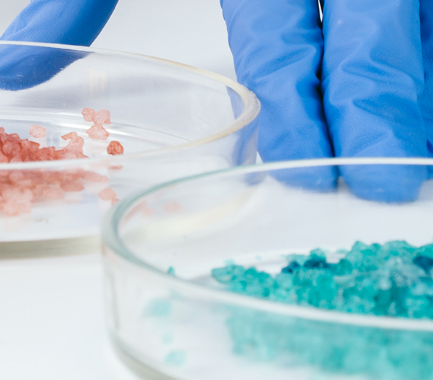Your contact
PENPET-Team - Hamburg

Tim Meister
Sales
Tel. +49 (0) 40 - 675 7 99 40
sales@penpet.de
Get in touch with us.
Terephthalic acid (PTA)
Terephthalic acid is one of the dicarboxylic acids and, as a raw material for the production of polyethylene terephthalate (PET), is one of the most important intermediate products in the chemical industry. On an industrial scale, the compound is mainly obtained by oxidizing p-xylene using catalysts. In the long term, however, this process based on fossil raw materials is to be replaced by synthesis from renewable raw materials. Various laboratory approaches already exist for this purpose, which are to be further developed into industrially usable processes.
Terephthalic acid is primarily used as a starting material for the production of polymer plastics. The esterification with ethylene glycol to form polyethylene terephthalate (PET) plays the most important role in the production of plastic bottles and food packaging. The substance is also used in the production of tear-resistant polyamide fibers and thermally resistant polyesters such as polybutylene terephthalate. In smaller amounts, terephthalic acid is also used as an intermediate to obtain other industrially used compounds.
At PENPET you can order the required amount of terephthalic acid in an uncomplicated and sustainable way. We look forward to receiving your inquiry for an individual offer. The solid is delivered as a powder in big bags, sacks or loose in a silo truck.
CAS no. 100-21-0
EINECS no. 202-830-0
Molecular formula: C8H6O4
Synonyms: para-phthalic acid, p-phthalic acid, TPA, TPS, 1,4-benzenedicarboxylic acid, BDC, terephthalic acid
Areas of application: Starting material for the production of polyethylene terephthalate (PET), resistant polyamides and polyesters for thermally demanding applications
More Information
Terephthalic acid is a dicarboxylic acid with a symmetrical structure. The center of the molecule is formed by a phenyl ring. The compound thus has aromatic properties and can undergo addition reactions. Carboxy groups are attached to two opposite carbon atoms of the phenyl structure. This means that terephthalic acid has two reactive functional groups. The structure of the substance allows, among other things, esterification with polyhydric alcohols to form linear or network-shaped polymers.
Terephthalic acid has two structurally similar isomers, phthalic acid and isophthalic acid, which differ from it in the different arrangement of the carboxylic acid groups on the phenyl ring.
Terephthalic acid is a colorless to white solid that is traded and processed in the form of a fine powder. At high temperatures, the substance goes directly into the gas phase. The compound has a sour smell.
The substance is sparingly soluble in water and in many common organic solvents such as chloroform, diethyl ether, ethanol and methanol. However, terephthalic acid has some solubility in dimethyl sulfoxide and dimethylformamide and basic solvents. Due to its higher density, the compound will settle to the bottom of the vessel upon contact with water.
Terephthalic acid is chemically stable. In contact with strong oxidizing agents, however, the substance reacts with intense heat development. The compound is combustible, but difficult to ignite. However, the turbulence of fine dust from terephthalic acid can lead to the formation of explosive dust-air mixtures. The substance should therefore be kept away from sources of ignition such as sparks, open flames and electrostatic charges. Greater caution is also required when handling opened containers. When burning and thermally decomposing terephthalic acid, irritating and harmful substances are released. In the event of a fire, appropriate respiratory protection must be worn.
According to the GHS classification, terephthalic acid is not considered a hazardous substance, has only a very low toxicity and is not subject to any special transport regulations. However, it is possible to have slight irritation and reddening of the respiratory tract, skin and eyes caused by the compound. After direct contact with the substance, the affected parts of the body should be rinsed thoroughly with water and a medical examination should be sought.
Ingestion of the compound can cause gastrointestinal symptoms such as nausea, diarrhea and vomiting. In this case, water should be drunk after rinsing the mouth. In tolerance studies on animals, the ingestion of large amounts of terephthalic acid led to the formation of dangerous bladder stones and bladder tumors as well as a disruption of the lipid metabolism, so that damage to human health cannot be ruled out either.
Terephthalic acid is considered to be slightly hazardous to water. Penetration of the compound into the ground, water or sewage system must therefore be avoided and reported to the responsible authorities.
